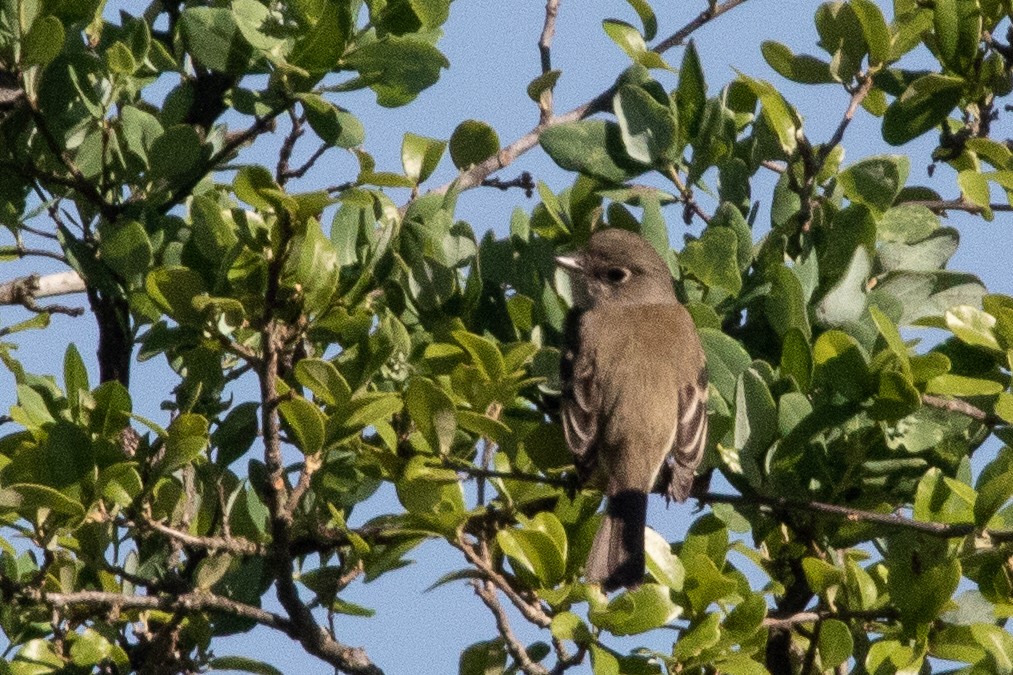Least Flycatcher
A species of Empidonax flycatchers, Also known as Chebec Scientific name : Empidonax minimus Genus : Empidonax flycatchers
Least Flycatcher, A species of Empidonax flycatchers
Also known as:
Chebec
Botanical name: Empidonax minimus
Genus: Empidonax flycatchers
Description
The least Flycatcher is a small, drab bird found in woodlands, forests, and suburban areas in North America. It feeds on insects, caught in the air or taken from leaves and twigs. The bird's call is a distinctive "chebec" song. It is easily distinguished from other flycatchers by its small size and simple, brownish-gray plumage. Despite its unassuming appearance, the Least Flycatcher is an active and agile bird, flitting from perch to perch in search of its next meal. 
Size
13 cm (5.25 in)
Colors
Black
Bronze
Gray
White
Life Expectancy
8 years
Nest Placement
Tree
Feeding Habits
Least Flycatcher's diet consists mainly of insects, such as ants, beetles, flies, butterflies, leafhoppers, wasps, winged ants, caterpillars, midges, true bugs, grasshoppers, spiders, and other invertebrates. They forage both in midair and off vegetation, typically from perches less than 50 feet high. This bird is known for its characteristic slow search behavior, involving frequent perch-switching and rotations for a broad view. Hovering is a prominent foraging tactic, alongside hawking, flush-chasing, and, less commonly, gleaning. They also occasionally consume berries and seeds.
Habitat
Least Flycatcher inhabits semi-open deciduous and mixed woodlands, typically found in North American shrubby fields and forest peripheries. Adapted to varied environments, it also occupies areas with clearings and aspen groves, occasionally in coniferous forests. It migrates to Central America for winter, preferring woodland fringes and tropical forests below 5,000 feet. Urbanization has extended its range to include human-altered landscapes such as parks and orchards.
Nest Behavior
After pairing, least Flycatcher spends 5-7 days building the nest, where the female weaves the materials. Both sexes may be involved in caring for the young.
Nest Characteristics
Least Flycatcher typically selects deciduous trees with upright forks for nesting, ranging from 2-50 feet high. The compact cup nest, about 2.5 inches wide and 2 inches tall, is crafted with bark strips, grasses, fibers, and spiderwebs, lined with fine materials and sometimes pilfered from nearby nests.
Dite type
Insectivorous
People often ask
Migration Overview
Least flycatchers’ age and sex groups migrate at different intervals. In Fall, adult males leave the breeding ground first, followed by adult females about a week later. The younger ones only join the rest of the group a month later. Fall migration occurs in July and early August, peaking in late-August. In the Fall migration, it has been reported that populations living in the west first migrate east before heading south. From the East, they then fly down to the Tropics. A few of them establish themselves for the winter in southern Florida, but most of them choose to spend their winter on the coasts of Central America. Once in that region, they inhabit wooded ravines of the Pacific slope or the dense bushes and wooded edges habitats of the Caribbean side. The least flycatcher leaves its wintering ground relatively early in comparison to other birds, arriving back north in late April to mid-May. It is thought that they can afford to arrive so early because they can subsist on small-sized insects which are out early in spring. They might also arrive early because of their highly competitive breeding site selection – a product of their habit to breed in clustered distribution. The least flycatcher spends its breeding season in southern Yukon to central Quebec and Maritime Provinces, in Wyoming Indiana, New Jersey and in the mountains of North Carolina. The breeding season only last about 64 days, after which they return south in the Tropics. The adult least flycatcher molts after migrating to its wintering ground, which differs from most other passerines. The juveniles, on the other hand, molt prior and throughout their Fall migration. The reason why the molt of the adults is delayed remains unclear, but might be due to the highly competitive site selection of winter habitat, where the first to arrive are the first to be served. 
General Info
Feeding Habits
Bird food type
Bird Feeder Type

Platform
Sounds
Call
Recording location: Mexico
Behavior
Least Flycatcher exhibit assertive territorial behaviors, vigorously defending their space against various intruders, including larger bird species. Their daily activities center around maintaining their territory through aggressive displays such as feather fluffing, wing extending, and tail flicking from crouched stances. Least Flycatcher demonstrate a social aspect in their breeding habits, preferring to nest in communal clusters, which may afford them enhanced protection against predators and increased mating opportunities. Courtship rituals involve a series of movements including perch hopping and silent flights, leading to both monogamous and extra-pair mating practices. On their wintering grounds, least Flycatcher continue to assert territorial boundaries through vocalizations, with males and females occupying separate areas.
Distribution Area
The least flycatcher inhabits the Eastern Rockies of Canada, and the Central-North and Northeastern United-States. During winter, they migrate to Central America and establish themselves from Mexico to Panama. The least flycatcher lives in aspen clusters, orchards, shade trees and open woods. They breed in deciduous or mixed forests and occasionally in coniferous groves. They tend to prefer breeding sites near clearing or edges but can also nest in dry woods. They spend the winter in Central America where they nest in forest edges and second growth. The least flycatcher also made its way in the open country. They often live in villages or city parks, nesting in shade trees and orchards, or along rural roads and forest edges. 
Species Status
Not globally threatened.
Scientific Classification
Phylum
Chordates Class
Birds Order
Perching birds Family
Tyrant flycatchers Genus
Empidonax flycatchers Species
Least Flycatcher 